
Taking advantage of fluorescence has greatly increased the arsenal of laboratory techniques to study biological processes.
- Subject:
- Biology
- Science
- Material Type:
- Lecture
- Provider:
- LabXchange
- Provider Set:
- LabXchange Videos
- Date Added:
- 10/25/2023

Taking advantage of fluorescence has greatly increased the arsenal of laboratory techniques to study biological processes.

Build your own miniature "greenhouse" out of a plastic container and plastic wrap, and fill it with different things such as dirt and sand to observe the effect this has on temperature. Monitor the temperature using temperature probes and digitally plot the data on the graphs provided in the activity.

Explore how the Earth's atmosphere affects the energy balance between incoming and outgoing radiation. Using an interactive model, adjust realistic parameters such as how many clouds are present or how much carbon dioxide is in the air, and watch how these factors affect the global temperature.
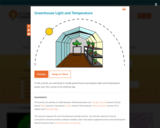
Make your own miniature greenhouse and measure the light levels at different "times of day"--modeled by changing the angle of a lamp on the greenhouse--using a light sensor. Next, investigate the temperature in your greenhouse with and without a cover. Learn how a greenhouse works and how you can regulate the temperature in your model greenhouse.

This article features science lesson plans to teach elementary students about the sun's energy, the relationship between light and heat, albedo, and the absorption of different surfaces. National standards and literacy integrations are provided for each lesson.
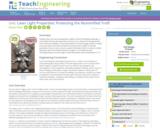
Students learn and use the properties of light to solve the following challenge: "A mummified troll was discovered this summer at our school and it has generated lots of interest worldwide. The principal asked us, the technology classes, to design a security system that alerts the police if someone tries to pilfer our prized possession. How can we construct a system that allows visitors to view our artifact during the day, but invisibly protects it at night in a cost-effective way?"

Students learn the basic properties of light the concepts of light absorption, transmission, reflection and refraction, as well as the behavior of light during interference. Lecture information briefly addresses the electromagnetic spectrum and then provides more in-depth information on visible light. With this knowledge, students better understand lasers and are better prepared to design a security system for the mummified troll.

Concepts underlying the first of the Essential Principles of the Climate Sciences are aligned with topics typically taught in the elementary grades. This article identifies lessons that will help elementary students develop an understanding of how Sun's light warms Earth and how variations in daylight hours are associated with seasonal change. This article appears in the free, online magazine Beyond Weather and the Water Cycle.

This tutorial explains light absorption, reflection and transmission in a clear and concise manner. Provides a "Check Your Understanding" section as well as additional links on color and light.

Through an introduction to the design of lighting systems and the electromagnetic spectrum, students learn about the concept of daylighting as well as two types of light bulbs (lamps) often used in energy-efficient lighting design.
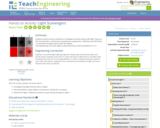
Students examine various materials to investigate how they interact with light. They use five characteristicsâtranslucency, transparency, opaqueness, reflectivity and refractivityâto describe how light interacts with the objects.

Students determine the refractive index of a liquid with a simple technique using a semi-circular hollow block. Then they predict the refractive index of a material (a Pyrex glass tube) by matching it with the known refractive index of a liquid using the percent light transmission measurement. The homemade light intensity detector uses an LED and multimeter, which are relatively inexpensive (and readily available) compared to commercially available measurement instruments.
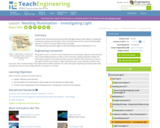
This is the first lesson of this unit to introduce light. Lessons 1-5 focus on sound, while 6-9 focus on light. In this lesson, students learn the five words that describe how light interacts with objects: "transparent," "translucent," "opaque," "reflection" and "refraction."

Learn about absorption and emission by creating a laser. Pump the chamber with a photon beam, and manipulate the energy states of the laser's atoms to control its output.

An interactive simulation that teaches about molecules, photons, and absorption by exploring how light interacts with molecules in our atmosphere. Through this simulation students can get a better understanding of the importance of the ozone layer and the effect greenhouse gasses have on the climate. This simulation can either be downloaded or played online and includes handouts, lesson plans, and additional materials.

Considers the reflection of light from both smooth and rough surfaces and the law of reflection.
A free CK-12 account is required to view all materials.

The operation of Polaroid filters on a pair of sunglasses is shown.
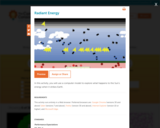
How does energy flow in and out of our atmosphere? Explore how solar and infrared radiation enters and exits the atmosphere with an interactive model. Control the amounts of carbon dioxide and clouds present in the model and learn how these factors can influence global temperature. Record results using snapshots of the model in the virtual lab notebook where you can annotate your observations.

Use shaving cream to design pretty paper in this hands-on experiment. Links to video of the experiment.
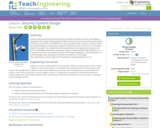
Students apply everything they have learned about light properties and laser technologies to designing, constructing and presenting laser-based security systems that protect the school's mummified troll. In the associated activity, students "test their mettle" by constructing their security system using a PVC pipe frame, lasers and mirrors. In the lesson, students "go public" by creating informational presentations that explain their systems, and serve as embedded assessment, testing each student's understanding of light properties.